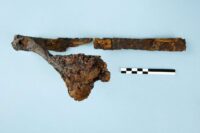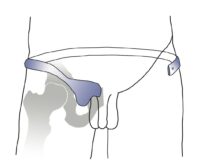 A mysterious object discovered in Aalst, Flanders, 16 years ago has been identified as an 18th century hernia truss. The band was made of metal, leather and a ball and was worn so the ball applied pressure to the weak spot in the groin to keep the intestines from protruding. Such devices have been used for centuries, but they are rare on the archaeological record. A few have been found elsewhere in the Netherlands, but this is the first one ever discovered in Flanders.
A mysterious object discovered in Aalst, Flanders, 16 years ago has been identified as an 18th century hernia truss. The band was made of metal, leather and a ball and was worn so the ball applied pressure to the weak spot in the groin to keep the intestines from protruding. Such devices have been used for centuries, but they are rare on the archaeological record. A few have been found elsewhere in the Netherlands, but this is the first one ever discovered in Flanders.
 The object was unearthed during an excavation of the Hopmarkt, a square in the historic heart of Aalst. The site of a Carmelite monastery that had stood for 300 years, the area was surveyed from March 2004 until the end of 2005 to salvage any archaeological material before construction of an underground car park. The monastery was founded in 1497 and ran continuously until it was dissoluted by the French Revolutionary authorities in 1797. The buildings, including the church, were sold off and dedicated to various purposes over the years (meat market, theater, textile workers guild hall, private homes). Most of them were demolished after World War II.
The object was unearthed during an excavation of the Hopmarkt, a square in the historic heart of Aalst. The site of a Carmelite monastery that had stood for 300 years, the area was surveyed from March 2004 until the end of 2005 to salvage any archaeological material before construction of an underground car park. The monastery was founded in 1497 and ran continuously until it was dissoluted by the French Revolutionary authorities in 1797. The buildings, including the church, were sold off and dedicated to various purposes over the years (meat market, theater, textile workers guild hall, private homes). Most of them were demolished after World War II.
 The dig explored the remains of three main areas of the defunct monastery: the church, the cloister and the gardens. It was in the western cloister alley (built in 1643) that a corroded object of unknown purposes was discovered in the burial layer. It took years of research to figure out what the rusty piece was.
The dig explored the remains of three main areas of the defunct monastery: the church, the cloister and the gardens. It was in the western cloister alley (built in 1643) that a corroded object of unknown purposes was discovered in the burial layer. It took years of research to figure out what the rusty piece was.
In an extraordinary fluke, researchers think they’ve identified the poor fellow who wear the belt, thanks to quality monastic record-keeping. Extant records from the monastery include burial registers and daily logs going back at least to 1643.
“At the moment, we are conducting another study in which we are analysing the Codex 156. That is a very old book that is in the library of the University of Leuven,” [Jan] Moens [of the Flanders Agency for Immovable Heritage] said. “It also contains the accounts of the Carmelite monastery of Aalst from 1738 to 1796. And the name of brother Patrick, the patient who suffered from an inguinal hernia, also appears in it.”
In the Codex, there is a first mention under the year 1754, when the monastery paid five nickels for the belt
“Such a belt is not expensive when you compare it to the other costs in the list, it cost about as much as a chicken back then,” he said.
A new report was found in 1758, then explicitly mentioning the name of monk Patrick. “It is very special that so many years later and after further research, we can even put a face to an 18th century find about which we were in the dark for a long time.”